My Tulip Poplar Art
The Tulip Poplar Tree
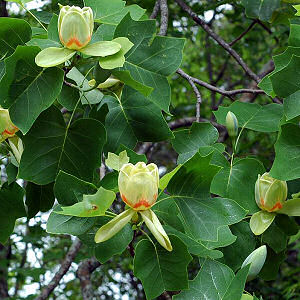
The Tulip poplar is not a poplar, but actually a huge magnolia and is the biggest, tallest, heaviest tree in the Eastern forest now that the American Chestnut has gone extinct. The wood is easily worked and is a standby in the furniture industry. No less an authority than Daniel Boone said Tulip poplars made the best dug out canoes. It is the state tree of Kentucky, Indiana, and Tennessee and is a strong contender against the California Redwood for the as yet unnamed national tree of the United States.
The "tulip" in the name comes from the showy, tulip shaped yellow flowers which mainly occur in the top most branches of the tree. It is a fast growing tree, reaching a maximum heights of 120 feet in about as many years, with a 4-5 foot diameter, though heights of 80-100 feet are more common.
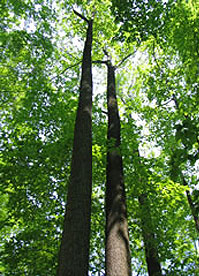
The branches are brittle and it is native to North America, some leaves will turn yellow and drop during drought. It attracts hummingbirds, birds, and squirrels and is a host plant for tiger and spicebush swallowtail butterflies.
Spicebush Tiger
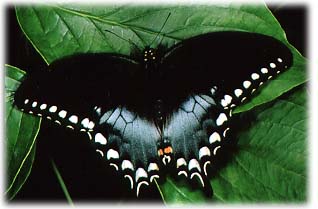
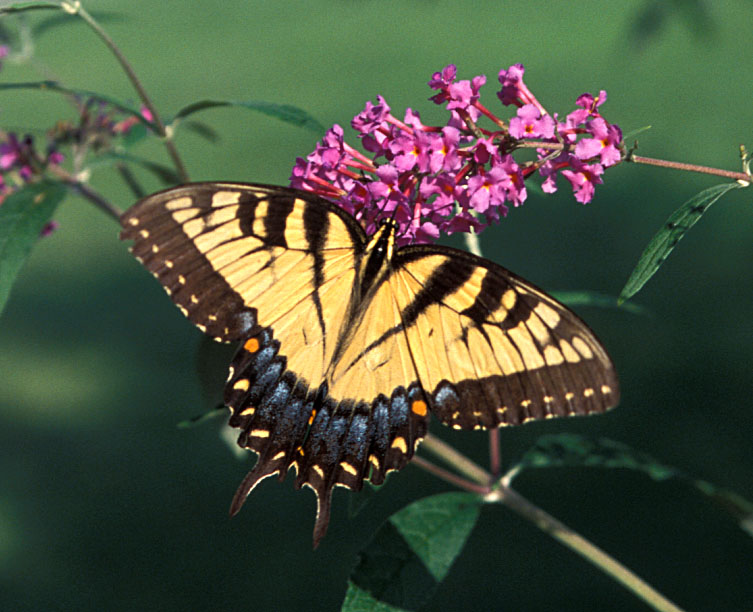
Tuliptree seeds, maturing in summer and persisting into winter, provide food for both birds and mammals, including finches, cardinals, quail, mice, red squirrels, gray squirrels, and rabbits.
The Tulip Poplar consistently displays brilliant fall color, whether planted as a shade or ornamental tree.
The tree's deep green leaves turn yellow in the fall, making it very beautiful in all seasons.
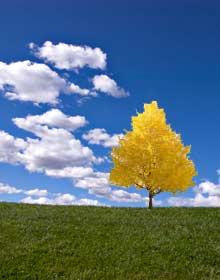
Its cup-shaped flowers resemble tulips, and are considered to be the largest flowers to bloom on a tree.
These beautiful flowers give you a delightful fragrance of nectar that you'll enjoy all spring long. This nectar even attracts birds and other small wildlife... the perfect tree for animal lovers!
It is also known as the "Yellow-poplar", "tulip tree" and "canoewood".
Tulip Poplars can grow to over 100 feet; the few remaining old growth specimens approach 200 feet. The bark of a mature tree breaks into vertical ridges in much the same way as an oak, but the ridges are greenish grey and turn white at the tops. You will also notice horizontal patches of light grey higher up the tree.
Tulip poplar is an important secondary wood in early American furniture.
Tuliptrees, with their tall, straight trunks, lack of lower branches, and hard wood, were favorites of loggers for railroad ties and fence posts. George Washington planted Tuliptrees at Mount Vernon which are now 140 feet tall.
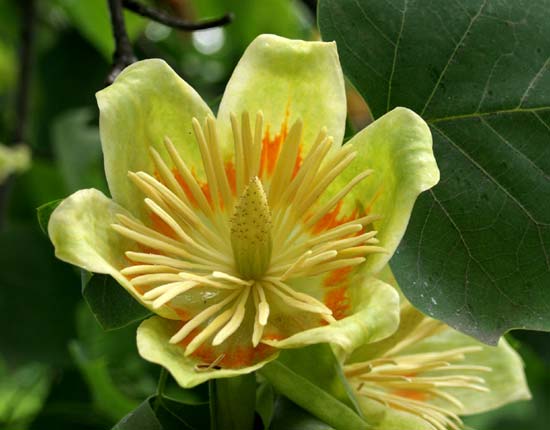
It will also make for good canoes and can be used for boat planking in a pinch. Daniel Boone is said to have preferred tulip poplars for canoes; in 1799, when he wore out his welcome in Kentucky, he hauled his whole family and all of his belongings to Spanish Missouri in a tulip-poplar canoe.
A Tulip Poplar's age can be estimated from the density, darkness of color, and amount of furrows in the bark. The oldest living Tulip Poplar, located in New York, is approximately 225 years old.
Some of the largest tuliptrees in cultivation in the East owe their origins directly to George Washington or Thomas Jefferson. Both George Washington and Thomas Jefferson planted Tulip trees on their grounds. Old tulip poplars collected and planted by George Washington at his Mount Vernon Virginia mansion whose fertility is reduced due to age are being carefully pollinated in order to produce progeny with a historical ancestry.
Mount Vernon's garden has received a great deal of international attention about its efforts to preserve the botanical heritage of
the 13 surviving trees planted by Washington. Of the hundreds of trees planted by George Washington at Mount Vernon, only thirteen, survive today. The thirteen trees are two tulip poplars, two white ash, a white mulberry, a hemlock and seven American hollies.
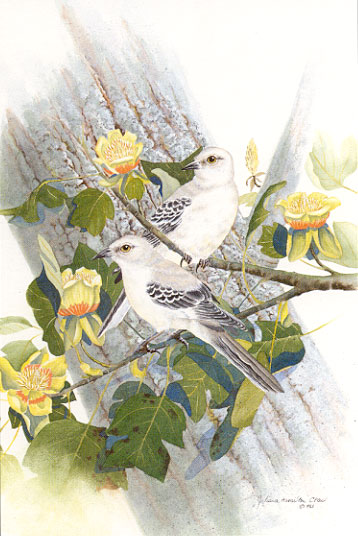
A Conversation with Janet Lembke
Date: Spring and Summer 2002
Here's the story of the yellow poplar, also known as the tulip poplar or tulip tree.
Many people greatly admire the yellow poplar, but it never stirred that sort of response in me. It was just a particular species of tree. The question: Do other people know something that I don't? And the search was on. I rambled around in the woods, both literal and metaphoric, looking at living yellow poplars, including the largest one in the U.S., and reading reports from botanists and others, like John Lawson, who published descriptions of North Carolina's trees in 1709. Lawson reports a man who lived in the hollowed-out trunk of a yellow poplar with all his household goods. Interesting, but hardly provocative of admiration. Then, oh then, a friend put me in touch with a professor of biology with whom she conducts spring searches for morel mushrooms, one of the most sought-after and succulent wild mushrooms. The professor told me that morels and yellow poplars are symbiotic, with their particular symbiosis known as mutualism, in which each participant depends for dear life on the other. Willy-nilly, I felt a surge of admiration for both tree and fungus. But the story didn't end there. It ended with the realization that as I finally found beauty in the tree, the tree didn't give a damn about what I felt.
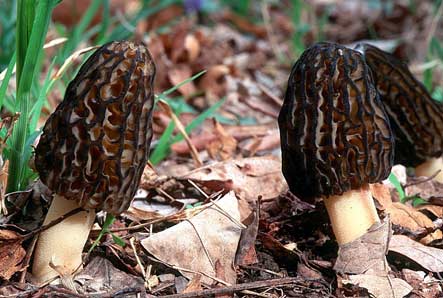
In the poem "Tulip Poplar," the state tree of his native Indiana, Norbert Krapf writes: "the twin flames / of love and memory / of those who / came before / and disappeared / into the dark."
Peter Huggins'
Leaving the Plains
When they come for me,
I won't be here.
I'll be in the woods
Among the foxes and raccoons.
A tulip poplar
Will be my home.
I'll forage for pecans,
Hunt wild grapes,
Fish for bass and bream.
Deer will give me their lives.
Squirrels will bring me
Blackberries and walnuts.
Mint tea will sustain me
As I become the wind
That wraps the white oaks
In a balm of light.
Purified by my quest,
Green martyr for my faith,
I'll leave the woods
And make the world my home.
************
Back